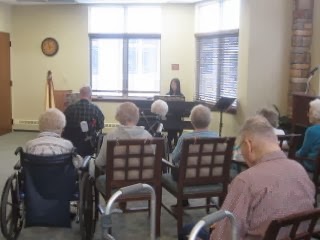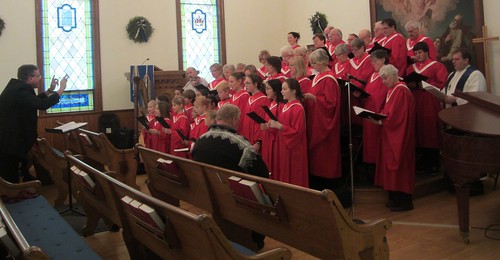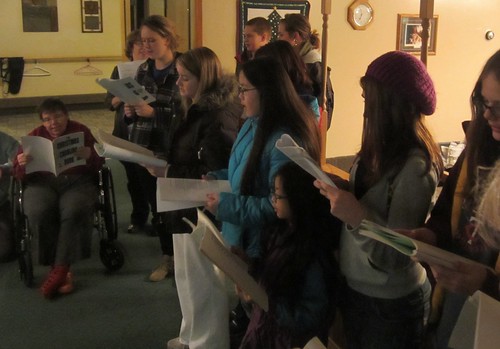Activity
Today’s focus was doing a harp and keyboard performance at the nursing home. We arrived early to help with the set-up of food - trays of meats, cheeses, cherry tomatoes, and olives.
The ladies were arranging food on Christmas-tree shaped trees.
Some of the ladies from the assisted living unit did the arranging of the food. It was a good way for them to do something creative, out of their "comfort zone" so it challenged them, and as a way to work collaboratively.
The women did a nice job arranging the food on the trays.
There were 26 residents including a couple family members who listened to the girls perform. It was nice because some of the residents we have developed friendships with made it a point to come down to the chapel to listen to the girls play the harp and piano.
The seniors listening to Sophia play the harp.
In some ways, it was a like performing for friends. In other ways, it was like having a room full of grandpas and grandmas who clapped after every piece the girls played.
Tia sang some songs as Sophia played the harp.
Some bowed their heads and closed their eyes as they listened to the Christmas songs. Others tapped their fingers to familiar beats. All listened intently.
Olivia played several songs on the piano.
Afterwards, many of the seniors came up to either the girls or me and thanked us for being there. One of the residents hugged Olivia and said, "I love you, Olivia." And not missing a beat, Olivia answered, "I love you too, Rita."
Emily, a 95 year old former school teacher, was so appreciative of hearing the girls play. She gave both the girls big hugs before she went back to her room.
One of the residents, John, who looks like Santa and who we enjoy visiting each time we're there; stayed longer so he could visit with us. He is never ready to back to his room when we are there. "You are my family," he has told us more than once.
It was a wonderful way to celebrate the anticipation of Christmas in two days. Between our visits this month on St. Nicholas Day, St. Lucia, Day, and today (for Christmas) - it truly has been one of the most meaningful months. The time we have spent with the seniors has shown us how time and sharing our gifts can make such a difference in others' lives.
*~*~*~*~*~*~*
Advent Reading
Matthew 1:22 - Now all this happened in order to make come true what the Lord had said through the prophet,
*~*~*~*~*~*~*
Christmas Joke
What do you have in December that you don't have in any other month? (The letter "D" !)
*~*~*~*~*~*~*
Christmas Fact
Today we learned where the tradition of caroling came from. The information is from Time magazine's website:
Christmas caroling as we know it dates back to the 19th Century and not much further. In fact, caroling itself didn't always involve Christmas, and the ancient tradition of traveling from house to house to wish neighbors good cheer didn't always involve singing.
There's a distinction to be made between carols — songs stemming from medieval musical traditions — and today's Christmas caroling, says Daniel Abraham, musicology expert and choral director at American University in Washington, D.C. "The concept of carol in its origins has actually nothing to do with Christmas," Abraham says.
Medieval carols were liturgical songs reserved for processionals in the 12th and 13th centuries. And though modern carols sometimes take their form from these original carols — starting with a refrain, followed by verses of uniform structure — they're separate entities.
The act of traveling to different homes comes from a different tradition altogether, albeit a similarly ancient one. In England, the word wassail — derived from the Old Norse ves heill meaning "be well, and in good health" — came to mean the wishing of good fortune on your neighbors.
No one is quite sure when the custom began, but it did give us the song, "Here We Come-A-Wassailing" — sung as carolers wished good cheer to their neighbors in hopes of getting a gift in return. ("A Wassailing" also evolved into the popular "We Wish You a Merry Christmas" — its last verse, "Bring us some figgy pudding" stems from the wassailers' original intent.)
The children and adult choirs singing together in 2011.
The two traditions of singing and visiting first merged in Victorian England, as church carols began to merge with Christian folk music. At that time, it was far from a Christmas tradition; festivals like May Day were deemed worthy of caroling, too, but the repertoire as well as early records of this are pretty unclear. In the 19th Century, as Christmas became more commercialized and popular, publishers began churning out anthologies of carols, many which were ancient hymns, also circulating them in broadsheets.
Many of our today's most popular carols date to this period. Christmas Carols Ancient and Modern published in London by British lawyer William B. Sandys in 1833, was the first to print "God Rest Ye Merry Gentlemen," "The First Noel" and "Hark! the Herald Angels Sing." "Joy to the World" first appeared in the Anglican Church hymnal Hymns Ancient and Modern in 1861.
Composed by Isaac Watts, known as the "father of Englsh hymnody", the song actually wasn't written exclusively for singing at Christmastime. Charles Wesley's "Hark the Herald Angels Sing" was originally "Hark! How All The Welkin Rings!" (Welkin means sky or heaven, and came to mean making a loud sound.)
The Oxford Book of Carols, first published in 1928, was a landmark book that combined medieval carols, folk songs and Christmas songs from around the world, publishing 201 of them in a 700-page volume. An updated version, the New Oxford Book of Carols, was published in 1992.
American caroling is far less common than it used to be, says Bob Thompson, professor of popular culture at Syracuse University. It's not unusual to see carolers standing still in a shopping mall or churchyard, but as for the random groups of friends traipsing to your doorstep for singing, don't count on it. "You talk to most baby boomers they might have a caroling story or two," says Thompson. "Talk to anybody born after 1960 or so and it's become much less common."
Sophia and Olivia with their 4-H group Christmas caroling in 2011.
Simply put, times and culture have changed. "The singing of Christmas carols at a stranger's door assumes a similarity of culture among carolers and audience," says Chris Brunelle, an assistant professor of classics at St. Olaf college. With America a far more diverse and less homogenous society than it was in caroling's heyday, that's a larger assumption than many are comfortable with.








No comments:
Post a Comment